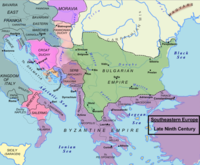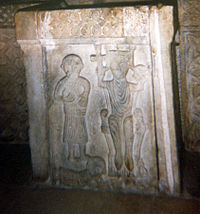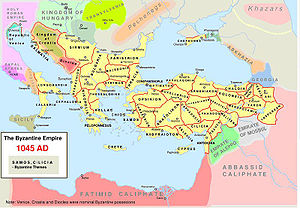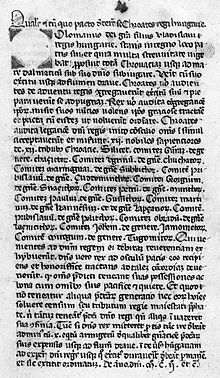- Kingdom of Croatia (medieval)
-
This article is about the medieval state. For the Habsburg Croatia, see Kingdom of Croatia (Habsburg).
Croat Kingdom
Kraljevstvo Hrvata
Regnum Chroatorum← 
←
925 - 1527  →
→Image of Europe, at the founding of the Croat Kingdom c. 925. The Kingdom is visible in the light-purple portion of the map. Capital Nin
Biograd
Knin
SolinLanguage(s) (early) Croatian, Latin Religion Christian,
later Roman CatholicGovernment Monarchy King - 925-928 Tomislav - 1050-1074 Peter Krešimir IV - 1089-1091 Stephen II of Croatia Historical era Middle Ages - Elevated to Kingdom 925 - Great Assembly of 925 in Split - Union with Hungary 1102 - Entered the Habsburg Monarchy January 1, 1527 Area - 11th century est. (mid) 105,000 km2 (40,541 sq mi) Area source ↓ The Kingdom of Croatia (Croatian: Kraljevina Hrvatska), also known as the Kingdom of the Croats (Croatian: Kraljevstvo Hrvata; Latin: Regnum Chroatorum or Regnum Croatorum), was a medieval kingdom covering most of what is today Croatia and Bosnia and Herzegovina in the Balkans.
Established in 925, it ruled as a sovereign state for almost two centuries. Its existence was characterized by various conflicts with the Venetians, Bulgarians, Magyars and, occasionally, the Pope. The goal of promoting the Slavic language in the religious service was initially brought and introduced by the 10th century bishop Gregory of Nin.[1] 1102, after a period of time defined as a succession crisis for the Trpimirović Dynasty, the kingdom lost its full sovereignty by the creation of a personal union with the Kingdom of Hungary. The Croatian kingdom de jure existed until 1918.
Contents
Early Croatian states
See also: Littoral Croatian DuchyArrival of Croats
 The Coming of the Croats to the Adriatic by Oton Iveković
The Coming of the Croats to the Adriatic by Oton Iveković
No contemporary written records about the migration have been preserved, especially not about the events as a whole and from the area itself. Instead, historians rely on records written several centuries after the facts, and even those records may be based on oral tradition.
The Croats were a Slavic tribe, coming into the Balkans from an area in and around today's Poland or western Ukraine. Many modern scholars believe that the early Croat people, as well as other early Slavic groups, were agricultural populations that were ruled by the nomadic Iranian-speaking Alans. It is unclear whether the Alans contributed much more than a ruling caste or a class of warriors; the evidence on their contribution is mainly philological and etymological.
The book De Administrando Imperio, written in the 10th century, is the most referenced source on the migration of Slavic peoples into southeastern Europe. It states that they migrated first around or before year 600[2] from the region that is now (roughly) Galicia and areas of the Pannonian plain, led by the Avars, to the province of Dalmatia ruled by the Roman Empire. De Administrando Imperio reports a folk tradition that the Croats were led into the Roman province of Dalmatia by a group of five brothers, Klukas, Lobel, Kosenc, Muhlo and Hrvat, and their two sisters, Tuga and Buga.[2]
The second[2] wave of migration, possibly around year 620, began when the Croats were invited by the Emperor Heraclius to counter the Avar threat on the Byzantine Empire.[2]
De Administrando Imperio also mentions an alternate version of the events, where the Croats weren't actually invited by Heraclius, but instead defeated the Avars and settled on their own accord after migrating from an area near today's Silesia. This record is supported by the writings of one Thomas the archdeacon, Historia Salonitana from the 13th century.
Archdeacon Thomas, as well as the Chronicle of the Priest of Duklja from the 12th century, state that the Croats remained after the Goths (under a leader referred to as "Totila") had occupied and pillaged the Roman province of Dalmatia. The Chronicle of Dioclea speaks of a Gothic invasion (under a leader referred to as "Svevlad", followed by his descendants "Selimir" and "Ostroilo").
Christianization
 The stone inscription of Prince Branimir, ca. 880
The stone inscription of Prince Branimir, ca. 880 White Croats (Chrobatia) on a map of the Holy Roman Empire around the year 1000. According to the map the land called Chrobatia is inhabited by the Vistulans and Lendians/Lechites, and/or near to Adriatic sea - Kingdom of Croatia.
White Croats (Chrobatia) on a map of the Holy Roman Empire around the year 1000. According to the map the land called Chrobatia is inhabited by the Vistulans and Lendians/Lechites, and/or near to Adriatic sea - Kingdom of Croatia.
The earliest record of contact between the Roman Pope and the Croats dates from a mid-7th century entry in the Liber Pontificalis. Pope John IV (John the Dalmatian, 640-642) sent an abbot named Martin to Dalmatia and Istria in order to pay ransom for some prisoners and for the remnants of old Christian martyrs. This abbot is recorded to have travelled through Dalmatia with the help of the Croatian leaders, and he established the foundation for the future relations between the Pope and the Croats.
The Christianization of the Croats began after their arrival, probably in the 7th century, influenced by the proximity of the old Roman cities in Dalmatia. The process was completed in the north by the beginning of the 9th century. The beginnings of the Christianization are also disputed in the historical texts: the Byzantine texts talk of duke Porin who started this at the incentive of emperor Heraclius, then of Prince Porga who mainly Christianized his people after the influence of missionaries from Rome, while the national tradition recalls Christianization during the rule of Dalmatian Prince Borna. It is possible that these are all renditions of the same ruler's name.
Curiously enough, the Croats were never obliged to use Latin -- rather, they held masses in their own language and used the Glagolitic alphabet[citation needed]. This was officially sanctioned in 1248 by Pope Innocent IV, and only later did the Latin alphabet prevail.
The Latin Rite prevailed over the Byzantine Rite rather early due to numerous interventions from the Holy See. There were numerous church synods held in Dalmatia in the 11th century, particularly after the East-West Schism, during the course of which the use of the Latin rite was continuously reinforced until it became dominant.
Rise of Croats
 The Adriatic Sklaviniae c. 800 AD, according to Nada Klaić
The Adriatic Sklaviniae c. 800 AD, according to Nada Klaić
Croatian lands in the Dark Ages were located between three major entities: the Eastern Roman Empire which aimed to control the Dalmatian city-states and islands, the Franks which aimed to control the northern and northwestern lands, and the Avars, later Magyars, and other fledgling states in the northeast. The fourth relevant group, but not so powerful with regard to the Croatian state, were the nearby Slavs in the southeast, the Serbs and the Bulgarians.
The north became subject to the Carolingian Empire around 800, when in 796 a Croatian Pannonian prince Vojnomir switched sides between the Avars and the Franks. The Franks established control over the region between Sava, Drava and Danube which was under the Margrave of Friuli. The patriarchy of Aquileia was then allowed to Christianize the remaining Slavs in the region. Charlemagne invaded the Dalmatian portion of Croatia in 799, contesting its Byzantine suzerainty, and after a lengthy war, conquered it in 803. The prince who headed the Croats in the south at the time was called Višeslav.
Charlemagne's invasion of the Dalmatian cities provoked a war with the Eastern Roman Empire — after a peace deal was signed, the Byzantium restored the city-states and islands while Charlemagne kept Istria and inland Dalmatia. After the death of Charlemagne in 814, the Frankish influence decreased, and the Croatian prince Ljudevit Posavski raised in Pannonia a rebellion (819). The Frankish Margraves sent armies in 820, 821 and 822, but each time they failed to crush the rebels until finally Ljudevit's forces withdrew to Bosnia. Most of the Pannonian Croatia would remain in Frankish suzerainty until the end of the 9th century. What is today eastern Slavonia and Srijem fell to the Bulgarians in 827 after a border dispute with the Franks. By a peace treaty in 845, the Franks were confirmed as rulers over Slavonia, whilst Srijem remained under Bulgarian clientage.
In the meantime, the Dalmatian Croats were recorded to have been subject to the Kingdom of Italy under Lothair I, since 828. The Croatian Prince Mislav (835–845) built up a formidable navy, and in 839 signed a peace treaty with Pietro Tradonico, doge of Venice. The Venetians soon proceeded to battle with the independent Slavic pirates of the Pagania region, but failed to defeat them. The Bulgarian king Boris I (called by the Byzantine Empire Archont of Bulgaria after he made Christianity the official religion of Bulgaria) also waged a lengthy war against the Dalmatian Croats, trying to expand his state to the Adriatic.
The Croatian Prince Trpimir I (845–864) succeeded Mislav and managed to finally win the war against the Bulgarians and their Rascian subjects. Trpimir I expanded his realm to include the whole of Bosnia up to the Drina river. Trpimir I managed to consolidate power over Dalmatia and much of the inland regions towards Pannonia, while instituting counties as a way of controlling his subordinates (an idea he picked up from the Franks). The first known written mention of the Croats, dates form March 4, 852, in statute by Trpimir. Trpimir is remembered as the initiator of the Trpimirović dynasty, that ruled in Croatia, with interruptions, from 845 until 1091.
In the meantime, the Saracens, a group of Arab pirates, invaded Taranto and Bari in the 840s. The extent of their piracy forced the Byzantium to increase its military presence in the southern Adriatic. In 867 a Byzantine fleet lifted the Saracen siege over Dubrovnik (then known as Ragusa) and also defeated the pirates of Pagania.
Facing a number of naval threats, the Croatian Prince Domagoj (864–876) built up the Croatian navy again and helped the Franks conquer Bari in 871[citation needed]. The Croatian vessels also forced the Venetians to start paying tribute for sailing near the eastern Adriatic coast. Domagoj's son, of unknown name, ruled Dalmatian Croatia between 876 and 878. His forces attacked the western Istrian towns in 876, but were subsequently defeated by the Venetian navy. His ground forces defeated the Pannonian duke Kocelj (861–874) who was suzerain to the Franks, and thereby shed the Frankish vassal status. Wars of Domagoj and his son liberated Dalmatian Croats from supreme Franks rule.
The next Prince Zdeslav (878–879) owerthrew Domagoj's son, but reigned briefly, only to see the Byzantine Empire conquer large portions of Dalmatia. He was then overthrown by Prince Branimir (879–892), who was supported by the Western Church, and the country was recognized by Pope John VIII as an independent principality under Branimir in 879 (Branimir was dubbed dux Chroatorum). Branimir proceeded to repel the Byzantine incursion and strengthen his state under the ægis of Rome. After Branimir's death, Prince Muncimir (892–910), Zdeslav's brother, took control of Dalmatia and ruled it independently of both Rome and Byzantium as divino munere Croatorum dux (with God's help, duke of Croats).
The last Prince of the Pannonian Croats under the Franks was Braslav (died in 897?), mentioned in 896, who died in a war with the Magyars, who then migrated to the Pannonian plain. In Dalmatia, Duke Tomislav (910–928) succeeded Muncimir. Tomislav successfully repelled Magyar attacks, expelled them up to the Drava River on north, and united Pannonian and Dalmatian Croats into one state.
Independent realm
Establishment
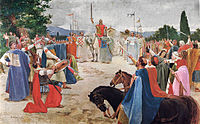 Crowning of King Tomislav by Oton Iveković
Crowning of King Tomislav by Oton Iveković
The Slavs arrived in the early 7th century in what is Croatia today. The first Croatian ruler recognized by the Pope was duke Branimir, whom Pope John VIII called dux Croatorum ("duke of Croats") in 879.[3] Croatia was elevated to the status of Kingdom around 925, when King Tomislav received the crown from the Papal legate. He united the Slavs of Dalmatia and Pannonia into a single Kingdom in 925. Tomislav's state extended from the Adriatic Sea to the Drava river, and from the Raša river to the Drina river. Under his rule, Croatia became one of the most powerful kingdoms in the Balkans.[4][5]
The state was ruled mostly by native Croats of Trpimirović dynasty until 1102, when the crown passed into the hands of the Hungarian Árpád dynasty. The act of union was sealed in Pacta conventa. Kingdom of Croatia and Hungary was from 1102, a personal union of two kingdoms, Kingdom of Croatia and Kingdom of Hungary, united under the Hungarian king.[6] At first, they were united under Arpad dynasty, and after its extinction, under Anjou dynasty. Croatia retained its chief institutions such as the Parliament (Croatian: Sabor - an assembly of Croatian nobles) and the ban (viceroy) responsible to the King of Hungary and Croatia.[7] In addition, the Croatian nobles retained their lands and titles.[8] Croatia remained a distinct crown attached to that of Hungary until the abolition of the Austro-Hungarian Empire in 1918.
 The wattle (pleter) with inscription "King Držislav", 10th century
The wattle (pleter) with inscription "King Držislav", 10th century
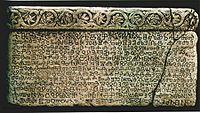 Baška tablet, 1100 AD
Baška tablet, 1100 AD
Tomislav, a descendant of Trpimir I, is considered the founder of the Trpimirović dynasty. Sometime between 923 and 928, Tomislav succeeded in uniting the Croats of Pannonia and Dalmatia, each of which had been ruled separately by dukes, and was crowned as king in the Duvno field[9] (the central town in the Duvno field is still named Tomislavgrad ("Tomislav's city") in his honour). The chief piece of evidence that Tomislav was crowned king comes in the form of a letter dated 925, surviving only in 16th-century copies, from Pope John X calling Tomislav rex Chroatorum. Tomislav's state covered most of Pannonia, Dalmatia, Bosnia, and Slavonia. He administered his kingdom as a group of eleven counties (županija) and one banate (Banovina). Each of these regions had a fortified royal town.
Tomislav soon came into conflict with the Bulgars under Emperor Simeon I (called Simeon the Great in Bulgaria). Tomislav made a pact with the Byzantine Empire, which allowed him to control the Byzantine cities in Dalmatia as long as he curbed Bulgarian expansion. In 926, Simeon tried to break the Croatian-Byzantine pact, sending duke Alogobotur with a formidable army against Tomislav, but Simeon's army was defeated in the Battle of the Bosnian Highlands. According to the contemporary De Administrando Imperio, Tomislav's army and navy could have consisted approximately 100,000 infantry units, 60,000 cavaliers, and 80 larger (sagina) and 100 smaller warships (condura), but generally isn't taken as credible.[10]
10th century
Croatian society underwent major changes in the 10th century. Local leaders, the župani, were replaced by the retainers of the king, who took land from the previous landowners, essentially creating a feudal system. The previously free peasants became serfs and ceased being soldiers, causing the military power of Croatia to fade.
Tomislav was succeeded by Trpimir II (928–935) and Krešimir I (935–945), who each managed to maintain their power and keep good relations with both the Byzantine Empire and the Pope. This period, on the whole, however, is obscure. Miroslav (945–949) was killed by his ban, Pribina, during an internal power struggle, and Croatia again lost the islands of Brač, Hvar, and Vis to the dukes of Pagania. The Dalmatian city-states and the Duchy of Bosnia were lost to Byzantium and eastern Slavonia and Srijem were taken by the Magyars.
Krešimir II (949–969) restored order throughout most of the state. He kept particularly good relations with the Dalmatian cities, he and his wife Jelena donating land and churches to Zadar and Solin. A 976 inscription is preserved the Church of Saint Mary in Solin that names the Croatian royalty.[11] Krešimir II was succeeded by his son Stjepan Držislav (969–997), who established better relations with the Byzantine Empire from which he has received a royal insignia.
11th century
As soon as Stjepan Držislav had died in 997, his three sons, Svetoslav (997–1000), Krešimir III (1000–1030), and Gojslav (1000–1020), opened a violent contest for the throne, weakening the state and allowing the Venetians under Pietro II Orseolo and the Bulgarians under Samuil to encroach on the Croatian possessions along the Adriatic. In 1000, Orseolo led the Venetian fleet into the eastern Adriatic and gradually took control of the whole of it,[12] first the islands of the Gulf of Kvarner and Zadar, then Trogir and Split, followed by a successful naval battle with the Narentines upon which he took control of Korčula and Lastovo, and claimed the title dux Dalmatiæ. Krešimir III tried to restore the Dalmatian cities and had some success until 1018, when he was defeated by Venice allied with the Lombards. His son, Stjepan I (1030–1058), only went so far as to get the Narentine duke to become his vassal in 1050.
During the reign of Krešimir IV (1058–1074), the medieval Croatian kingdom reached its territorial peak. Kresimir managed to get the Byzantine Empire to confirm him as the supreme ruler of the Dalmatian cities.[13] He also allowed the Roman curia to become more involved in the religious affairs of Croatia, which consolidated his power but disrupted his rule over the Glagolitic clergy in parts of Istria after 1060. Croatia under Krešimir IV was composed of twelve counties and was slightly larger than in Tomislav's time. It included the closest southern Dalmatian duchy of Pagania, and its influence extended over Zahumlje, Travunia, and Duklja.
However, in 1072, Krešimir assisted the Bulgarian and Serb uprising against their Byzantine masters. The Byzantines retaliated in 1074 by sending the Norman count Amik to besiege Rab. They failed to capture the island, but did manage to capture the king himself, and the Croatians were then forced to settle and give away Split, Trogir, Zadar, Biograd, and Nin to the Normans. In 1075, Venice banished the Normans and secured the cities for itself. The end of Kresimir IV in 1074 also marked de facto end of the Trpimirović dynasty, which had ruled the Croatian lands for over two centuries.
According to the Kartular of Supetar, a new king was elected by seven bans (if the previous one died without a successor e.g. Krešimir IV): ban of Croatia, ban of Bosnia, ban of Slavonia etc.[14] The bans were elected by the first six Croatian tribes, while the other six were responsible for choosing župans.
Krešimir was succeeded by a rival: Dmitar Zvonimir (1075–1089).[15] He was previously a ban in Slavonia. He gained the title of king with the support of Pope Gregory VII, after which he aided the Normans under Robert Guiscard in their struggle against the Byzantine Empire and Venice between 1081 and 1085. Zvonimir helped to transport their troops through the Strait of Otranto and to occupy the city of Durrës. His troops assisted the Normans in many battles along the Albanian and Greek coast. Due to this, in 1085, the Byzantines transferred their rights in Dalmatia to Venice. Zvonimir's kinghood is carved in stone on the Baška Tablet, preserved to this day as one of the oldest written Croatian texts, kept in the archæological museum in Zagreb. Zvonimir's reign is remembered as a peaceful and prosperous time, during which the connection of Croats with the Holy See was further affirmed, so much so that Catholicism would remain among Croats until the present day. In this time the noble titles in Croatia were made analogous to those used in other parts of Europe at the time, with comes and baron used for the župani and the royal court nobles, and vlastelin for the noblemen. The Croatian state was edging closer to western Europe and further from the east.
There was no permanent state capital, as the royal residence varied from one ruler to another; five cities in total reportedly obtained the title of a royal seat: Nin (Krešimir IV), Biograd (Stephen Držislav, Krešimir IV), Knin (Zvonimir, Petar Svačić), Šibenik (Krešimir IV), and Solin (Krešimir II).[16]
Decline and war
 Death of King Peter on Gvozd Mountain in the year 1097 by Oton Iveković
Death of King Peter on Gvozd Mountain in the year 1097 by Oton Iveković
Demetrius Zvonimir (died 1089) was the King of Croatia of the Svetoslavić branch of the House of Trpimirović. He began as the Ban of Slavonia in the service of King Stephen I and then as Duke of Croatia for his successor King Peter Krešimir IV. Peter declared him his heir and, in late 1074 or early 1075, Demetrius Zvonimir succeeded to the Croatian throne. Demetrius Zvonimir married in 1063 to his distant relative Jelena Lijepa ("Jelena the Beautiful"). Queen Jelena (Ilona) was a Hungarian princess, the daughter of King Bela I of the Hungarian Árpád dynasty, and was the sister of the future King Ladislaus I of Hungary. Demetrius Zvonimir and Jelena had a son, Radovan, who died in his late teens or early twenties. King Demetrius Zvonimir died in 1089. The exact circumstances of his death are unknown, but according to a later, likely unsubstantiated legend, King Zvonimir was killed during the revolt of the Sabor in 1089.[17] With no direct heir to succeed him, Stephen II (reigned 1089–1091) of the main Trpimirović line came to the throne at an old age and reigned for two years. This succession was contested by a faction of nobles from northern Croatia (Pannonia). The nobles offered the Croatian throne to King Ladislaus I of Hungary, who claimed the Croatian crown through his sister Queen Jelena, King Demetrius Zvonimir's widow. The Queen enjoyed significant influence in northern Croatia and apparently used it to bolster her brother's claim.
Stephen II was to be the last King of the House of Trpimirović. His rule was relatively ineffectual and lasted less than two years. He spent most of this time in the tranquility of the monastery of Sv. Stjepan pod Borovima (St. Stephen beneath the Pines) near Split. He died at the beginning of 1091, without leaving an heir. Since there was no living male member of the House of Trpimirović, civil war and unrest broke out shortly afterward. At the same time (1091), with the death of Stephen II setting the stage, King Ladislaus I of Hungary at last accepted the nomination of northern nobles and claimed the Croatian crown. He entered the Croatian Kingdom with an army in 1094, and established his rule in northern Croatia (Pannonia) with little resistance. During the same year (1094) he founded the Zagreb bishopric, which later became the ecclesiastical center of Croatia. However, Ladislaus' claim was rejected by the nobles of southern Croatia, who resisted his forces successfully in the mountainous southern terrain and maintained their independence. At this time, the Byzantine Emperor Alexius I Comnenus sent the Cumans to attack Hungary and forced the Hungarian army to retreat from Croatia. Alexius did, however, allow the Hungarian Prince Álmos to rule over northern Croatia (Pannonia).
In 1093, the southern Croatian feudal lords, struggling to remain independent of Hungary, elected a new ruler, King Peter Svačić (reigned 1093–1097). He managed to unify the Kingdom around his capital of Knin and force the Hungarian Prince Álmos from northern Croatia in 1095. With this he restored Croatian rule up to the river Drava, reclaiming nearly all territory lost to Ladislaus I, who soon died in 1095.
 Croatian Kingdom c. 1097-1102, during succession crisis.
Croatian Kingdom c. 1097-1102, during succession crisis.
Ladislaus' successor and nephew was King Coloman, and he resolved to press the Hungarian claim on the Croatian crown and continue the campaign. He made peace with Pope Urban II and led a large army into the Croatian Kingdom in 1097. Under his leadership, a Hungarian army quickly defeated King Peter's defenses along the river Drava and regained control over the Pannonian Croatian plains (northern Croatia). His forces were stopped however, as they approached the mountainous southern regions which resisted the Hungarian claim. He therefore reassembled his forces in Croatia and advanced on Gvozd Mountain, where he met the main Croatian army assembled under King Peter. In the ensuing Battle of Gvozd Mountain, King Peter was killed and the Croats were decisively defeated (because of this, the mountain was with time renamed to Petrova Gora, "Peter's Mountain"). As a consequence of the battle, King Coloman gained control of most of Croatia without resistance. However, when in 1099 Coloman and his forces were called back to the northeast to fight the Ruthenians and Cumans in Galicia, the Croatian nobles took the opportunity to liberate themselves from Hungarian rule once again. In 1102, Coloman returned to the Kingdom of Croatia in force, and negotiated with the Croatian feudal lords from a position of power. As a consequence, King Coloman was crowned and the Hungarian and Croatian crowns were joined (with the crown of Dalmatia held separate from that of Croatia). The title now claimed by Coloman was "King of Hungary, Dalmatia, and Croatia".
Controversies
The events surrounding the union of Croatia and Hungary are the source of a major historical controversy.[18] Croatian historians argue that the union was a personal one in the form of a shared king, while Hungarian historians insist that Croatia was conquered.[19] The significance of the debate lies in the Croatian claim to an unbroken heritage of historical statehood which is clearly compromised by the other claim.[19] The Hungarian claim was made in the 19th century during the Hungarian national reawakening, while the same argument could also be levelled about the idea of a personal union first articulated in the 14th century.[20] The actual nature of the relationship is inexplicable in modern terms because it varied from time to time.[20] Sometimes Croatia acted as an independent agent and at other times as a vassal of Hungary.[20] However, Croatia retained a large degree of internal independence.[20] The degree of Croatian autonomy fluctuated throughout the centuries as did its borders.[21]
According to the research of the Library of Congress a faction of Croatian nobles contesting the succession after the death of Zvonimir offered the Croatian throne to King Ladislaus I.[22] In 1091 Ladislaus accepted, and in 1094 he founded the Zagreb bishopric, which later became the ecclestical center of Croatia.[22] King Coloman of Hungary crushed opposition after the death of Ladislaus I and won the crown of Dalmatia and Croatia in 1102.[22] The crowning of King Coloman forged a link between the Croatian and Hungarian crowns that lasted until the end of World War I (1918).[22] The status of the Croatian Kingdom in this new situation is disputed, however. Croats have maintained for centuries that, despite the voluntary union of the two crowns, the Kingdom of Croatia remained a sovereign state in a personal union with the Kingdom of Hungary. Hungarians, however, claim that Hungary annexed Croatia outright in 1102. In either case, Hungarian culture permeated northern Croatia, the Croatian-Hungarian border shifted often, and at times Hungary treated Croatia as a vassal state. Croatia, however, had its own local governor, or Ban; a privileged landowning nobility; and an assembly of nobles, the Sabor.[22]
Other sources say King Coloman established a personal union of the Kingdom of Croatia and the Kingdom of Hungary[23] by an alleged agreement called Pacta conventa. Although, the precise time and terms of Pacta Conventa later became a matter of dispute; nonetheless there was at least a non-written agreement that regulated the relations between Hungary and Croatia in approximately the same way.[24] According to Daniel Power Croatia became part of Hungary in the late 11th and early 12th century.[25] The official entering of Croatia into a personal union with Hungary, becoming part of the Lands of the Crown of St. Stephen, had several important consequences. Institutions of separate Croatian statehood were maintained with the Sabor (parliament) and the ban (viceroy)[24] in the name of the king. A single ban governed all Croatian provinces until 1225, when the authority was split between one ban of the whole of Slavonia and one ban of Croatia and Dalmatia. The positions were intermittently held by the same person after 1345, and officially merged back into one by 1476.
Union with Hungary
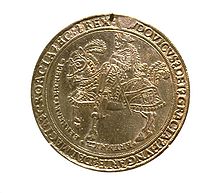 Coin of Louis II of Hungary with the inscription in Latin: "Louis by the grace of God King of Hungary, Dalmatia, Croatia"
Coin of Louis II of Hungary with the inscription in Latin: "Louis by the grace of God King of Hungary, Dalmatia, Croatia"
In the union with Hungary, institutions of separate Croatian statehood were maintained through the Sabor (an assembly of Croatian nobles) and the ban (viceroy). In addition, the Croatian nobles retained their lands and titles.[26] Coloman retained the institution of the Sabor and relieved the Croatians of taxes on their land. Coloman's successors continued to crown themselves as Kings of Croatia separately in Biograd na Moru until the time of Bela IV.[27] In the 14th century a new term arose to describe the collection of de jure independent states under the rule of the Hungarian King: Archiregnum Hungaricum (Lands of the Crown of Saint Stephen).[28]
Feudalism
The Hungarian king also introduced a variant of the feudal system. Large fiefs were granted to individuals who would defend them against outside incursions thereby creating a system for the defence of the entire state. However, by enabling the nobility to seize more and more economic and military power, the kingdom itself lost influence to the Frankopan, Šubić, Lacković, Nelipčić, Kačić, Kurjaković, Drašković, Babonić and other families. During this period, the Knights Templar and the Knights Hospitaller also acquired considerable property and assets in Croatia.
The later kings sought to restore their influence by giving certain privileges to the towns, making them Royal Boroughs or Free Royal Towns, which the kings defended from the feudal lords in return for the town's support.
The princes of Bribir from the Šubić family became particularly influential during the time of Pavao Šubić Bribirski (1272–1312) who asserted control over large parts of Dalmatia, Slavonia and Bosnia during an internal conflict between the Árpád and Anjou ruling dynasties. Later, however, the Anjouvines intervened and scattered the Šubić and Babonić (1322 ad) families across the country (an important offspring being the Zrinski family). During that time, Angevian kings won a full control over Slavonia and Croatia. The reign of Louis the Great (1342–1382) is considered the golden age of Croatian medieval history.[29] Hungarian power was restored in Dalmatia in 1358 AD by the Treaty of Zadar (later, in the time of reign king Sigismund I Luxembourg this province was sold to the Republic of Venice in 1409.
History of Croatia 
This article is part of a seriesEarly history Prehistoric Croatia Origins of the Croats White Croatia Medieval history Littoral Croatia · Pannonian Croatia · Pagania · Zachlumia · Travunia Kingdom of Croatia March of Istria Republic of Poljica Republic of Dubrovnik Kingdom of Bosnia Habsburg Empire Kingdom of Croatia Croatian Military Frontier Illyrian Provinces · Kingdom of Illyria Kingdom of Slavonia Kingdom of Dalmatia Kingdom of Croatia-Slavonia State of Slovenes, Croats, and Serbs Yugoslavia Kingdom of Yugoslavia
(Banovina of Croatia)World War II
Independent State of Croatia
Federal State of CroatiaSocialist Republic of Croatia Contemporary Croatia War of independence Republic of Croatia
Croatia Portal
Ottoman wars
As the Turkish incursion into Europe started, Croatia once again became a border area between two major forces in the Balkans. While Croats under Italian Franciscan priest fra John Capistrano and the Hungarian Generalissimo John Hunyadi contributed to the Christian victory over the Ottomans in the siege of Belgrade of 1456, they suffered a major defeat in the battle of Krbava field (in Lika, Croatia) in 1493 and gradually lost increasing amounts of territory to the Ottoman Empire.
Pope Leo X called Croatia the forefront of Christianity (Antemurale Christianitatis) in 1519, given that several Croatian soldiers made significant contributions to the struggle against the Turks. Among them there were ban Petar Berislavić who won a victory at Dubica on the Una river in 1513, the captain of Senj and prince of Klis Petar Kružić, who defended the Klis Fortress for almost 25 years, captain Nikola Jurišić who deterred by a magnitude larger Turkish force on their way to Vienna in 1532, or ban Nikola Šubić Zrinski who helped save Pest from occupation in 1542 and fought in the Battle of Szigetvar in 1566.
The 1526 Battle of Mohács was a crucial event in which the rule of the Jagiellon dynasty was shattered by the death of King Louis II. The defeat emphasized the overall inability of the Christian feudal military to halt the Ottomans, who would remain a major threat for centuries. The Croatian historical narrative insists that the decision to join the Habsburg Empire was the result of a free choice made by the Sabor.[20] Austrian historians never claimed they conquered Croatia by force and there appears to be little reason to doubt Croatian claims about the events of 1526.[30]
Union after 1526
The Battle of Mohács and the death of King Louis II ended Hungarian rule over Croatia. In 1526 the Hungarian parliament elected János Szapolya as the new king of Hungary, but a separate Hungarian parliament elected Ferdinand Habsburg. The Croatian parliament at Cetin unanimously elected Ferdinand Habsburg of Austria as King of Croatia on 1 January 1527,[31] uniting both lands under Hapsburg rule. The Ottoman Empire expanded further in the 16th century to include most of Slavonia, western Bosnia and Lika.
Croatia had now become so weak that it's parliament allowed Ferdinand Habsburg to reallocate large areas of Croatia and Slavonia adjacent to the Ottoman Empire, creating the Croatian Krajina (Vojna Krajina, German: Militärgrenze) which was ruled directly from Vienna military headquarters.[32] The area however became deserted and was subsequently settled by Serbs, Vlachs, Croats, Germans and others. As a result of compulsory military service to the Habsburg Empire during the wars against the Ottoman Empire, the Military Frontier was free from serfdom and enjoyed a great deal of political autonomy, unlike areas ruled by the King.
After the Bihać fort finally fell in 1592, only small areas of Croatia remained unrecovered. The Ottoman Army was successfully repelled for the first time in Croatia at the battle of Sisak in 1593, restoring further areas of lost territory but failed to regain large parts of what is now Bosnia and Herzegovina.
During the 18th century, the Ottoman Empire was driven out of Hungary, and Austria brought the empire under central control. Empress Maria Theresa of Austria was supported by the Croatians in the 1741-1748 War of Austrian Succession and subsequently made significant contributions to Croatian matters.
With the fall of the Venetian Republic in 1797, its possessions in the eastern Adriatic became subject to a dispute between France and Austria. By 1815 Dalmatia and Istria had been secured by the Austrian Empire, though they were annexed to Cisleithania, while Croatia and Slavonia remained Hungarian territories.
Croatian romantic nationalism emerged in mid-19th century to counteract the apparent Germanisation and Magyarisation of Croatia. The Illyrian movement attracted a number of influential figures from the 1830s onwards, and produced some important advances in the Croatian language and culture.
In the Revolutions of 1848 Croatia, driven by fear of Magyar nationalism, supported the Habsburg court against Hungarian revolutionary forces. However, despite the contributions of Ban Jelačić in quenching the Hungarian war of independence, Croatia was not treated any more favourably by Vienna than Hungary itself and lost its domestic autonomy. In 1867 the Dual Monarchy was created; Croatian autonomy was restored in 1868 with the Croatian–Hungarian Agreement which, although not particularly favourable to the Croatians, recognised Croatia as a state within the Kingdom of Hungary.
See also
- Kingdom of Croatia (Habsburg)
- Kingdom of Croatia-Slavonia
- History of Croatia
- Pacta conventa (Croatia)
- Crown of Zvonimir
- Lands of the Crown of Saint Stephen
- Ottoman Hungary
- Bans of Croatia
- Timeline of Croatian history
References
- ^ (Croatian) Hrvatski glagoljizam i stradanje dalmatinskih gradova
- ^ a b c d http://www.croatianhistory.net/etf/et01.html#white
- ^ Stjepan Antoljak, Pregled hrvatske povijesti, Split 1993., str. 43.
- ^ Opća enciklopedija JLZ. Zagreb. 1982.
- ^ (Croatian) Zoran Lukić - Hrvatska Povijest
- ^ "Croatia (History)". Encarta. http://encarta.msn.com/encyclopedia_761577939_6/Croatia.html#p40.
- ^ History of Croatia to the Ottoman conquests
- ^ "Croatia (History)". Britannica. http://www.britannica.com/EBchecked/topic/143561/Croatia/223953/History.
- ^ http://assets.cambridge.org/97805218/94524/frontmatter/9780521894524_frontmatter.pdf
- ^ De Administrando Imperio, Byzantine Emperor Constantine VII Porphyrogenitos, 950
- ^ Mihajlo Kresimir II and Jelena (946 - 969)
- ^ festa della sensa - Veniceworld.com
- ^ (Croatian) PETAR KREŠIMIR IV.TRPIMIROVIĆ
- ^ http://www.hercegbosna.org/STARO/ostalo/pabirci.html
- ^ Croatian Coat Of Arms And Popes
- ^ Ferdo Šišić, Povijest Hrvata; pregled povijesti hrvatskog naroda 600. - 1918., Zagreb ISBN 953-214-197-9
- ^ (Croatian) Kletva kralja Zvonimira nad hrvatskim narodom
- ^ Bellamy, p.36
- ^ a b Bellamy, p.37
- ^ a b c d e Bellamy, p. 38
- ^ Singleton, p. 29
- ^ a b c d e Curtis, Glenn E. (1992). "A Country Study: Yugoslavia (Former) - The Croats and Their Territories". Library of Congress. http://memory.loc.gov/frd/cs/yutoc.html. Retrieved 2009-03-16.
- ^ Font, Marta:Hungarian Kingdom and Croatia in the Middle Age
- ^ a b Britannica:History of Croatia
- ^ Power, Daniel (2006). The Central Middle Ages: Europe 950-1320. Oxford University Press. pp. 186. ISBN 9780199253128.
- ^ http://www.britannica.com/EBchecked/topic/143561/Croatia
- ^ Curta, Stephenson, p. 267
- ^ Ana S. Trbovich (2008). A Legal Geography of Yugoslavia's Disintegration. Oxford University Press. p. 87. ISBN 9780195333435.
- ^ Zrinka Pešorda Vardić: The crown, the king and the town – the relation of Dubrovnik community toward the crown and the ruler in the beginning of movement against the Court (Croatian Institute of History)
- ^ Bellamy, p. 39
- ^ R. W. SETON -WATSON:The southern Slav question and the Habsburg Monarchy page 18
- ^ Charles W. Ingrao:The Habsburg monarchy, 1618-1815 page 15
Sources
- Bellamy, Alex J. (2003). The Formation of Croatian National Identity: A Centuries-old Dream. Manchester University Press. ISBN 9780719065026.
- Singleton, Frederick Bernard (1985). A short history of the Yugoslav peoples. Cambridge University Press. ISBN 9780521274852.
- Curtis, Glenn E. (1992). "A Country Study: Yugoslavia (Former) - The Croats and Their Territories". Library of Congress. http://memory.loc.gov/frd/cs/yutoc.html. Retrieved 2009-03-16.
- CroatianHistory.Net
Categories:- Former monarchies of Europe
- Former countries in Europe
- States and territories established in 925
- States and territories disestablished in 1527
- Kingdom of Croatia
- History of Hungary
- Kingdom of Hungary
- Former countries in the Balkans
- Former Slavic countries
- Medieval Croatia
Wikimedia Foundation. 2010.




